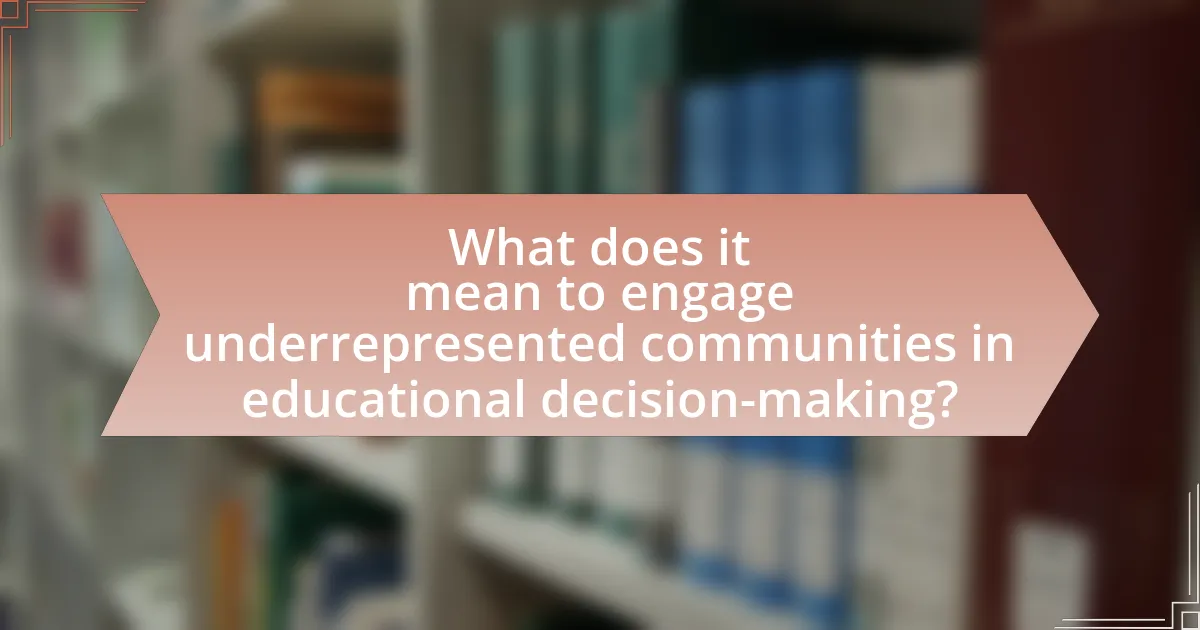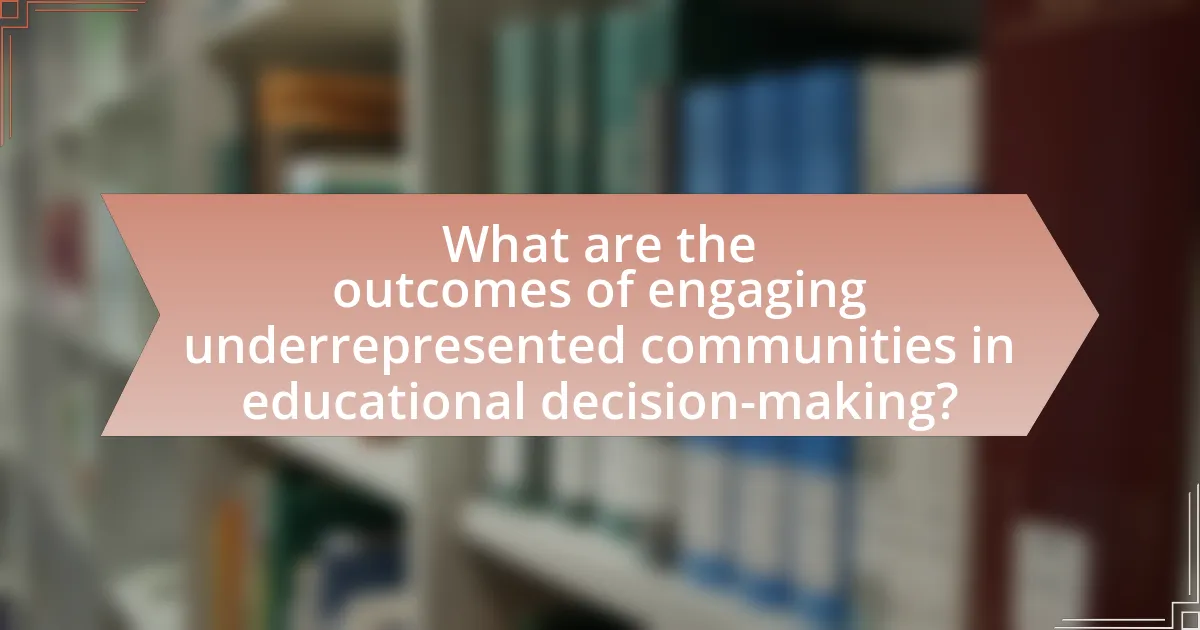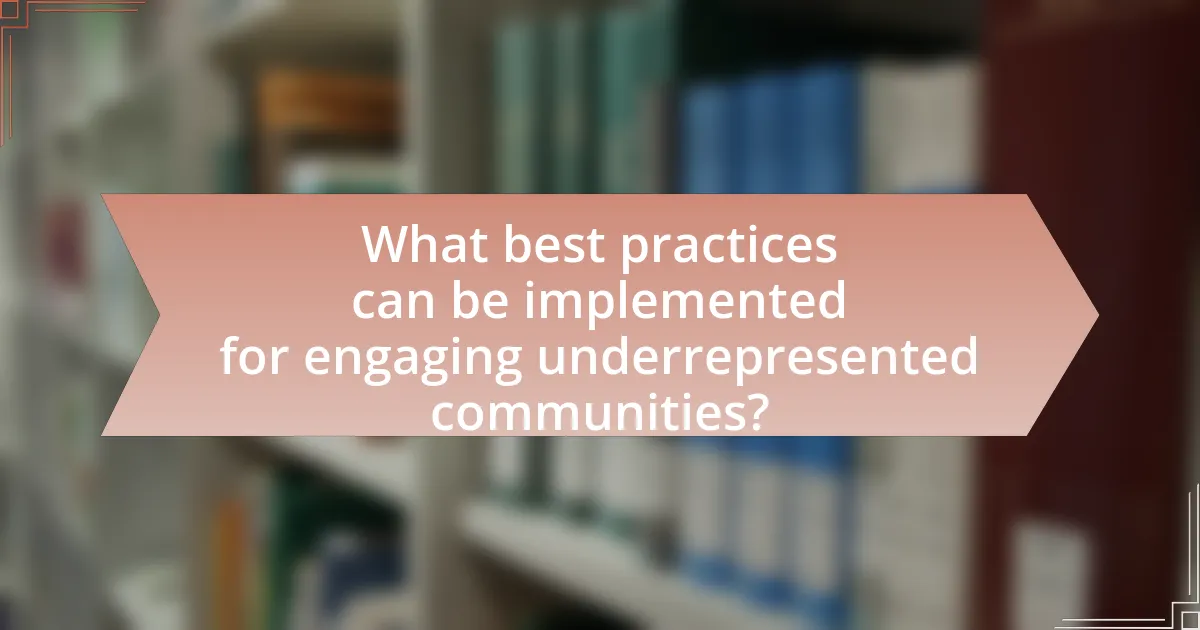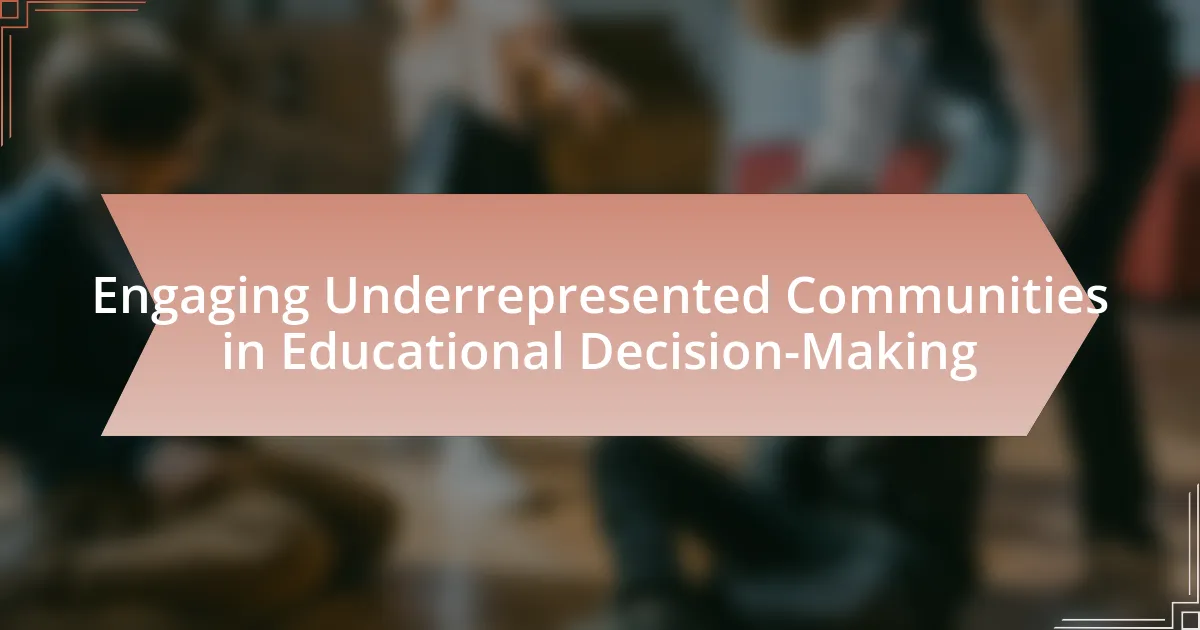Engaging underrepresented communities in educational decision-making involves actively including marginalized groups, such as low-income families, racial and ethnic minorities, and individuals with disabilities, in shaping educational policies and practices. This engagement is crucial for fostering equity and inclusivity, as it leads to more relevant educational outcomes and improved student performance. The article explores the importance of including these communities, the potential negative impacts of their exclusion, and effective strategies for enhancing their participation. It also discusses the systemic barriers that hinder engagement and highlights best practices for educational institutions to build trust and collaboration with underrepresented populations.

What does it mean to engage underrepresented communities in educational decision-making?
Engaging underrepresented communities in educational decision-making means actively involving these groups in the processes that shape educational policies, practices, and outcomes. This engagement ensures that the voices, needs, and perspectives of marginalized populations, such as low-income families, racial and ethnic minorities, and individuals with disabilities, are considered in decisions that affect their educational experiences. Research indicates that when underrepresented communities participate in decision-making, it leads to more equitable educational systems and improved student outcomes, as evidenced by studies showing that inclusive practices can enhance academic achievement and foster a sense of belonging among students.
Why is it important to include underrepresented communities in educational decisions?
Including underrepresented communities in educational decisions is crucial for fostering equity and inclusivity in the education system. When these communities participate, their unique perspectives and needs are acknowledged, leading to more relevant and effective educational policies and practices. Research indicates that inclusive decision-making can improve student outcomes; for instance, a study by the National Education Association found that schools with diverse leadership teams are better at addressing the needs of all students, resulting in higher academic achievement and engagement levels. Therefore, integrating underrepresented voices not only enhances educational equity but also contributes to the overall success of the educational system.
What are the potential impacts of excluding these communities?
Excluding underrepresented communities from educational decision-making can lead to significant negative impacts, including a lack of diverse perspectives in policy development and a failure to address the unique needs of these communities. This exclusion can result in educational inequities, as decisions may not reflect the realities or challenges faced by marginalized groups, ultimately perpetuating systemic disparities. Research indicates that inclusive decision-making processes enhance educational outcomes and foster a sense of belonging among all students, as evidenced by studies showing improved academic performance in schools that actively engage diverse stakeholders.
How does inclusion benefit the educational system as a whole?
Inclusion benefits the educational system as a whole by fostering a diverse learning environment that enhances academic outcomes and social cohesion. Research indicates that inclusive educational practices lead to improved student performance, as diverse perspectives contribute to richer discussions and critical thinking. For instance, a study by the National Center for Learning Disabilities found that inclusive classrooms can boost the academic achievement of all students, not just those with disabilities, by promoting collaboration and empathy. Furthermore, inclusive education prepares students for a diverse workforce, equipping them with the skills necessary to thrive in a multicultural society. This holistic approach ultimately strengthens the educational system by creating a more equitable and supportive learning atmosphere for all students.
Who qualifies as an underrepresented community in education?
Underrepresented communities in education include racial and ethnic minorities, low-income individuals, individuals with disabilities, and those from rural areas. These groups often face systemic barriers that limit their access to quality education and resources. For instance, according to the National Center for Education Statistics, students from low-income families are less likely to graduate high school compared to their higher-income peers, highlighting the educational disparities faced by these communities.
What characteristics define underrepresented communities?
Underrepresented communities are characterized by their limited access to resources, representation, and opportunities in various societal sectors, including education, employment, and political participation. These communities often include racial and ethnic minorities, low-income individuals, people with disabilities, and other marginalized groups who face systemic barriers. For instance, according to the U.S. Census Bureau, racial and ethnic minorities make up a significant portion of the population yet are often underrepresented in leadership roles and decision-making processes, highlighting disparities in representation. Additionally, studies show that these communities frequently experience lower educational attainment and economic mobility, further illustrating their underrepresentation in critical areas of society.
How do socioeconomic factors influence representation in education?
Socioeconomic factors significantly influence representation in education by affecting access to resources, opportunities, and decision-making processes. Individuals from lower socioeconomic backgrounds often face barriers such as inadequate funding for schools, limited access to advanced coursework, and fewer extracurricular opportunities, which can hinder their academic performance and engagement. Research indicates that schools in affluent areas typically receive more funding, leading to better facilities and educational programs, while schools in economically disadvantaged areas struggle with underfunding and overcrowding (National Center for Education Statistics, 2021). Consequently, this disparity in resources results in a lack of representation for underprivileged communities in educational decision-making, as their voices are often marginalized in discussions about policies and reforms that directly impact their educational experiences.
What barriers exist to engaging underrepresented communities in educational decision-making?
Barriers to engaging underrepresented communities in educational decision-making include systemic inequities, lack of representation, and insufficient access to information. Systemic inequities manifest in policies that do not prioritize the needs of these communities, leading to a disconnect between decision-makers and the populations they serve. Lack of representation in leadership roles further exacerbates this issue, as decisions may not reflect the diverse perspectives and needs of underrepresented groups. Additionally, insufficient access to information prevents these communities from fully understanding the decision-making processes and their implications, which can discourage participation. Research indicates that when communities are not adequately informed or represented, their voices are often marginalized, resulting in decisions that do not align with their interests or needs.
What systemic issues contribute to these barriers?
Systemic issues that contribute to barriers in engaging underrepresented communities in educational decision-making include socioeconomic disparities, lack of representation, and institutional biases. Socioeconomic disparities limit access to resources and opportunities, making it difficult for these communities to participate effectively. Lack of representation in decision-making bodies perpetuates a cycle where the needs and perspectives of underrepresented groups are overlooked. Institutional biases, often embedded in policies and practices, can marginalize these communities further, leading to a lack of trust and engagement in the educational system. For instance, research by the National Education Association highlights that schools in low-income areas often receive fewer resources, exacerbating these systemic issues.
How do cultural differences affect engagement efforts?
Cultural differences significantly affect engagement efforts by influencing communication styles, values, and expectations within diverse communities. For instance, collectivist cultures may prioritize group consensus and relationship-building over individual opinions, which can lead to different approaches in decision-making processes. Research by Hofstede indicates that cultural dimensions, such as individualism versus collectivism, directly impact how communities engage with educational initiatives. Understanding these cultural nuances is essential for tailoring engagement strategies that resonate with specific communities, thereby enhancing participation and effectiveness in educational decision-making.
How can educational institutions effectively engage underrepresented communities?
Educational institutions can effectively engage underrepresented communities by implementing inclusive outreach programs that prioritize collaboration and representation. These programs should involve community leaders and stakeholders in decision-making processes, ensuring that the voices of underrepresented groups are heard and valued. Research indicates that when educational institutions actively involve community members in shaping policies and practices, it leads to increased trust and participation, as evidenced by the findings in the report “Engaging Communities in Education: A Guide for Schools” by the National Education Association, which highlights successful case studies of community engagement initiatives.
What strategies have proven successful in fostering engagement?
Successful strategies for fostering engagement include building trust through consistent communication, involving community members in decision-making processes, and providing accessible resources tailored to the community’s needs. Research indicates that when educational institutions actively involve underrepresented communities in shaping policies and practices, engagement levels significantly increase. For instance, a study by the National Education Association found that schools that implemented collaborative decision-making frameworks saw a 30% increase in community participation. This demonstrates that inclusive practices not only enhance engagement but also lead to more effective educational outcomes.
How can partnerships with community organizations enhance engagement?
Partnerships with community organizations enhance engagement by leveraging local knowledge and trust to foster deeper connections with underrepresented communities. These organizations often have established relationships and credibility within the community, which can facilitate open communication and encourage participation in educational decision-making processes. For instance, research by the National Education Association indicates that schools collaborating with community organizations see a 30% increase in parental involvement, demonstrating that such partnerships can effectively mobilize community resources and support.
What role does technology play in facilitating communication and involvement?
Technology plays a crucial role in facilitating communication and involvement by providing platforms that enable real-time interaction and information sharing. These platforms, such as social media, video conferencing, and collaborative tools, allow underrepresented communities to engage actively in educational decision-making processes. For instance, studies show that online forums and webinars can increase participation rates by up to 40%, as they remove barriers related to location and scheduling. Additionally, technology enhances accessibility by offering resources in multiple languages and formats, ensuring that diverse voices are heard and considered in decision-making.

What are the outcomes of engaging underrepresented communities in educational decision-making?
Engaging underrepresented communities in educational decision-making leads to improved educational outcomes and increased equity. Research indicates that when these communities participate, there is a greater alignment between educational policies and the actual needs of students, resulting in enhanced student engagement and achievement. For instance, a study by the National Education Association found that schools with active community involvement saw a 20% increase in student performance metrics. Additionally, involving diverse voices fosters a sense of ownership and accountability, which can lead to more culturally relevant curricula and support systems. This engagement not only empowers communities but also promotes systemic change within educational institutions.
How does engagement influence educational policies and practices?
Engagement significantly influences educational policies and practices by ensuring that diverse perspectives, particularly from underrepresented communities, are included in decision-making processes. This inclusion leads to more equitable and relevant educational policies that address the specific needs of these communities. For instance, research conducted by the National Education Association highlights that schools with active community engagement initiatives see improved student outcomes and higher levels of satisfaction among parents and educators. By fostering collaboration between schools and communities, educational practices can be tailored to reflect the cultural and social contexts of all students, thereby enhancing overall educational effectiveness.
What changes have been observed in schools that prioritize community input?
Schools that prioritize community input have observed increased student engagement and improved academic outcomes. Research indicates that when schools actively involve parents and community members in decision-making processes, students tend to perform better academically, as evidenced by a study from the Harvard Family Research Project, which found that schools with strong family and community engagement saw a 10-20% increase in student achievement. Additionally, these schools often experience enhanced trust and collaboration between educators and families, leading to a more supportive learning environment. This collaborative approach fosters a sense of ownership among community members, which further contributes to positive changes in school culture and student success.
How does student performance correlate with community engagement?
Student performance positively correlates with community engagement, as active participation in community activities enhances students’ academic outcomes. Research indicates that students involved in community service or local initiatives often exhibit improved grades, higher attendance rates, and increased motivation. For instance, a study published in the “Journal of Educational Psychology” by Eyler and Giles (1999) found that students who engaged in service-learning demonstrated significant gains in academic performance compared to their peers who did not participate. This correlation suggests that community engagement fosters a supportive environment that contributes to better educational achievements.
What are the long-term benefits of sustained engagement with underrepresented communities?
Sustained engagement with underrepresented communities leads to improved educational outcomes and increased equity in decision-making processes. This engagement fosters trust and collaboration, allowing for the incorporation of diverse perspectives that enhance the relevance and effectiveness of educational policies. Research indicates that schools with strong community ties see higher student achievement and lower dropout rates, as evidenced by a study from the Harvard Family Research Project, which found that family and community engagement significantly contributes to student success. Additionally, sustained engagement promotes social cohesion and empowers communities, enabling them to advocate for their needs and influence educational reforms effectively.
How does this engagement affect community trust in educational institutions?
Engagement with underrepresented communities positively affects community trust in educational institutions by fostering transparency and inclusivity. When educational institutions actively involve these communities in decision-making processes, they demonstrate a commitment to addressing the specific needs and concerns of diverse populations. Research indicates that such engagement leads to increased perceptions of fairness and accountability, which are critical components of trust. For instance, a study by the National Education Association found that schools that engage parents and community members in decision-making see a 20% increase in trust levels among those communities. This collaborative approach not only enhances the legitimacy of educational policies but also encourages ongoing dialogue, further solidifying trust between institutions and the communities they serve.
What role does engagement play in promoting equity in education?
Engagement plays a crucial role in promoting equity in education by ensuring that underrepresented communities have a voice in decision-making processes. When educational institutions actively involve these communities, they can better address specific needs and barriers that affect equitable access to resources and opportunities. Research indicates that inclusive engagement leads to improved educational outcomes; for instance, a study by the National Education Association found that schools with strong community engagement initiatives saw a 20% increase in student achievement among marginalized groups. This demonstrates that engagement not only fosters a sense of belonging but also directly contributes to closing achievement gaps, thereby promoting equity in education.

What best practices can be implemented for engaging underrepresented communities?
To effectively engage underrepresented communities, organizations should prioritize inclusive communication strategies. This involves using culturally relevant messaging and accessible language to ensure that information reaches diverse audiences. Research indicates that tailored outreach efforts, such as community forums and partnerships with local leaders, significantly enhance participation rates among marginalized groups. For instance, a study by the National Education Association found that schools that actively involved community stakeholders in decision-making processes saw a 30% increase in engagement from underrepresented families. Additionally, providing resources in multiple languages and utilizing various media platforms can further bridge gaps in communication, fostering a more inclusive environment for educational decision-making.
What are some effective communication strategies for outreach?
Effective communication strategies for outreach include utilizing culturally relevant messaging, leveraging community leaders, and employing multiple communication channels. Culturally relevant messaging ensures that the information resonates with the target audience, increasing engagement and understanding. For instance, research shows that messages tailored to the cultural context of underrepresented communities can significantly enhance participation rates in educational initiatives. Engaging community leaders as trusted voices can facilitate outreach efforts, as they often have established relationships and credibility within the community. Additionally, employing various communication channels—such as social media, community events, and local media—ensures broader reach and accessibility, catering to diverse preferences and habits. Studies indicate that multi-channel approaches can lead to higher engagement levels, as they allow for repeated exposure and varied interaction opportunities.
How can educational leaders build relationships with community members?
Educational leaders can build relationships with community members by actively engaging in open communication and collaboration. This involves organizing regular community meetings to discuss educational initiatives, seeking input on decision-making processes, and creating partnerships with local organizations. Research indicates that schools that foster strong ties with their communities see improved student outcomes and increased trust, as evidenced by a study from the Harvard Family Research Project, which highlights the positive impact of community engagement on educational success.
What methods can be used to gather feedback from underrepresented communities?
To gather feedback from underrepresented communities, methods such as community surveys, focus groups, and participatory workshops can be employed. Community surveys allow for the collection of quantitative data from a broad audience, ensuring diverse voices are heard. Focus groups facilitate in-depth discussions, enabling participants to share their experiences and perspectives in a supportive environment. Participatory workshops actively involve community members in the decision-making process, fostering collaboration and ownership. These methods have been shown to increase engagement and ensure that feedback is representative of the community’s needs and concerns.
What resources are available to support engagement efforts?
Resources available to support engagement efforts include community organizations, educational toolkits, and funding opportunities. Community organizations often provide local insights and connections, facilitating outreach to underrepresented groups. Educational toolkits, such as those developed by the National Education Association, offer strategies and best practices for effective engagement. Additionally, funding opportunities from government agencies and foundations can help sustain initiatives aimed at involving diverse communities in educational decision-making processes. These resources collectively enhance the capacity to engage underrepresented populations effectively.
How can funding be secured for community engagement initiatives?
Funding for community engagement initiatives can be secured through a combination of grant applications, partnerships with local organizations, and crowdfunding efforts. Grant applications can be directed towards government agencies, foundations, and nonprofit organizations that prioritize community development and education, such as the National Endowment for the Arts or the Ford Foundation, which allocate millions annually for such initiatives. Partnerships with local organizations can leverage existing resources and networks, enhancing credibility and access to funding opportunities. Crowdfunding platforms like GoFundMe or Kickstarter can also mobilize community support and raise funds directly from individuals who are invested in the initiative. These methods have been proven effective, as evidenced by successful community projects that have raised substantial amounts through these channels, demonstrating their viability in securing necessary funding.
What training programs exist for educators to improve engagement skills?
Training programs that exist for educators to improve engagement skills include the “Culturally Responsive Teaching” program, which focuses on understanding and integrating students’ cultural backgrounds into the learning process. Another program is “Restorative Practices,” which emphasizes building relationships and community within the classroom to enhance student engagement. Additionally, the “Engagement Strategies for Diverse Learners” workshop provides educators with techniques to actively involve all students, particularly those from underrepresented communities. Research indicates that these programs can lead to improved student participation and academic outcomes, as evidenced by studies showing that culturally responsive practices increase engagement by 30% in diverse classrooms.
What practical steps can educational institutions take to enhance engagement?
Educational institutions can enhance engagement by implementing inclusive decision-making processes that actively involve underrepresented communities. This can be achieved through establishing advisory boards that include diverse community members, conducting regular outreach programs to gather input from these groups, and creating partnerships with local organizations that represent underrepresented populations. Research indicates that schools with community engagement initiatives see improved student outcomes and increased trust between families and educational institutions, as highlighted in the report “Engaging Families and Communities in Education” by the National Education Association.


